

Free teaching materials! Writing in the Ancient World. We are excited to announce the launch of our free teaching materials on Writing in the Ancient World, which includes teaching packs on five writing systems, cartoons and ideas for play sessions.
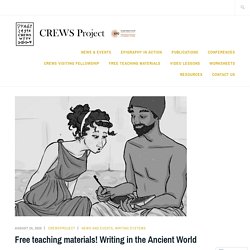
They were designed with age 8-11 children in mind (i.e. roughly Key Stage 2 in the UK), but we hope that they will be useful for a wide range of people and will reach an international audience. If you are interested in learning more, please click through to the links below. Writing in the Ancient World teaching materials. Les instruments de l'écriture.
Michel Feugère, Pierre-Yves Lambert et al. constantinienne, de l'hypogée de Trebius Justus, sur la via Latina, qui montre réunis un coffret, qui est sans doute un écritoire, 2 codices de tablettes avec leur poignée de transport, un étui à stylets, un jeu de calâmes avec leur encrier, un volumen déroulé et une boîte cylindrique pour le rangement des volumes (Andreae, 1973, p. 464, fig. 633).
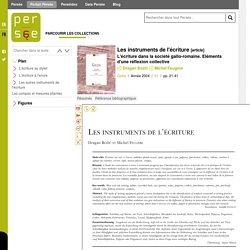
Jusqu'à une époque récente, on s'est assez peu intéressé aux instruments de l'écriture 23, seul comptait finalement l'acte et surtout son résultat. Mais dans les fouilles archéologiques, ces outils sont nettement plus courants que les documents écrits. La présence de ces instruments, leur type et leur fréquence sont des indicateurs de la diffusion de l'écriture - et de la lecture - dans les sociétés antiques.
Il importe donc de reconnaître les différents instruments de l'écriture, leurs caractères morphologiques et fonctionnels. Papyrus et parchemin dans l Antiquite greco romaine. Rome et le volumen - Histoire. Nadia Pla - C'est lundi ! Je partage avec vous le rituel... L'aventure des écritures. Deux Séquences "L'écriture dans l'Antiquité" pour les 6èmes. Schola et litterae - XV. Evolution of Latin Characters. Roman writing equipment from Verulamium (St Albans). Only the lamp & tablet are modern replicas. #RomanBritain.
A is for … the Ancient Roman Alphabet! A is for … the Ancient Roman Alphabet!

Ever wondered what Latin sounded like? Papyrus et parchemin dans l Antiquite greco romaine. 4. Palaeography - The Schoyen Collection. Palaeography, the study of the various types of old scripts and their development geographically and over time, is a vast field.
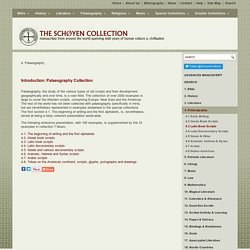
The collection of over 2000 examples is large to cover the Western scripts, comprising Europe, Near East and the Americas. The rest of the world has not been collected with palaeography specifically in mind, but are nevertheless represented in examples elsewhere in the special collections. Ecriture. La correspondance romaine - Civilisation romaine. La civilisation romaine est une civilisation d'écriture.
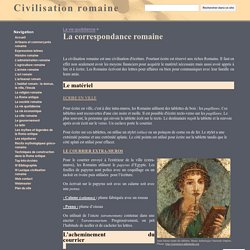
Pourtant écrire est réservé aux riches Romains. Il faut en effet non seulement avoir les moyens financiers pour acquérir le matériel nécessaire mais aussi avoir appris à lire et à écrire. Les Romains écrivent des lettres pour affaires ou bien pour communiquer avec leur famille ou leurs amis. Le matériel Pour écrire en ville, c'est à dire intra-muros, les Romains utilisent des tablettes de bois : les pugillares. Ancient Writing Materials. Vindolanda Tablet 118 Leaf No. 1 (front) Amo, Amas, Amat: Greco-Roman School Exercises – SARAH E. BOND. The first line of Euripides’ Bacchae reads: Although it was written by the playwright at the end of the 5th c.

BCE, while in Macedonia, the words of Euripides continued to echo in schoolrooms throughout the Mediterranean. (Kind of like how everyone in the U.S. seems to read The Great Gatsby in 9th grade.) The oldest writing tablets & oldest witnesses of the #Greek language. #Cyprus, ca. 800 BC. A nice explanation of how to fold a love curse tablet from @JohnsHopkins . #antivalentines. A splendid papyrus codex from Duke (P.DUK.INV. 729) preserves a couple of Roman love spells.
Technical and Scientific Analysis of the Curse Tablet. Recent research gives us insight into the curse tablet from a technical and scientific point of view.
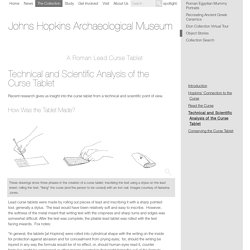
How Was the Tablet Made? These drawings show three phases in the creation of a curse tablet: inscribing the text using a stylus on the lead sheet; rolling the text; "fixing" the curse (and the person to be cursed) with an iron nail. Images courtesy of Natasha Jones. Lead curse tablets were made by rolling out pieces of lead and inscribing it with a sharp pointed tool, generally a stylus.
The lead would have been relatively soft and easy to inscribe. “In general, the tablets [at Hopkins] were rolled into cylindrical shape with the writing on the inside for protection against abrasion and for concealment from prying eyes; for, should the writing be injured in any way the formula would be of no effect, or, should human eyes read it, counter formulae might be composed or other means resorted to that might bring the evil of the formula back like a boomerang upon its author.”
Further Analysis. A splendid papyrus codex from Duke (P.DUK.INV. 729) preserves a couple of Roman love spells. Roman #ancientgraffito of a little boot in the hallway of The House of Menander, #Pompeii. Is that available as an e-book? David Saunders @GettyMuseum on deciphering the scroll. Boy reading a scroll, perhaps epic poetry: interior of an Attic cup, 470-450BC @GettyMuseum. Graffiti and public notices in Roman square capitals, Pompeii, 1920. Many were destroyed during World War II.
Roman Cursive Lesson 01 Learn to write like an Ancient Roman letterforms from Ostia. Ancient Writing Materials: Wood. Ecriture romaine : François Prost. Pour le plaisir des yeux: la reproduction de l'inscription que j'ai montrée ce matin dans le petit livre de G.
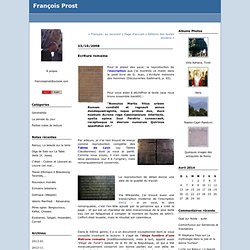
Jean, L'écriture mémoire des hommes (Découvertes Gallimard, p. 65). Pour vous aider à déchiffrer le texte (que nous lirons ensemble bientôt) : "Romulus Martis filius urbem Romam condidit et regnauit annos duodequadraginta, isque primus dux, duce hostium Acrone rege Caeninensium interfecto, spolia opima Ioui Feretrio consecrauit, receptusque in deorum numerum Quirinus appellatus est. " The original iPad: Diptych.